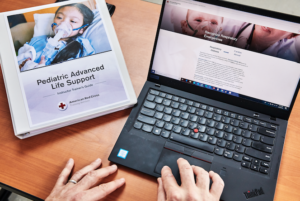Featured: American Red Cross Training Services
MANAGING SAFETY TRAINING DURING AND AFTER THE COVID-19 PANDEMIC

The COVID-19 pandemic is forcing immediate changes with enormous impacts to resuscitation training. While some environments are able to postpone all but essential training, many, including healthcare environments, do not have that ability.
Workplaces will always have risk and employees will always require training, be it for first aid, CPR, or advanced resuscitation skills. What must now change as a result of the COVID-19 pandemic is how companies prepare their employees. The challenge now becomes how to find ways to continue training while keeping employees safe.
A Roadmap for Training during Challenging Times
Tim Smith, the CEO of HeartCert CPR Training in Minneapolis, gave serious consideration to shutting down training operations when stay-at-home orders first came out. Then he started getting calls and emails from people who needed a certification as a job requirement. “They want to be in the workforce doing a certain job, and they couldn’t do it without their certification,” he explains.
Smith lays out a roadmap for how his organization – and others – are enabling training during this time.
Of greatest importance, follow public health guidance. Look at federal, state and local jurisdictions as well as the Centers for Disease Control and Prevention and the World Health Organization. Consider ways you can eliminate contact and minimize class sizes. If you typically train in groups of 12, you may have to now train in groups of 6 in order to follow six feet of social distancing as well as restrictions on sharing equipment. Gloves and masks are mandatory, and skills practice has been modified to comply with social distancing requirements.
Many training organizations send out screening guidelines ahead of time via email, telephone and text. The communications should always include a reminder of the potential signs of the novel coronavirus and instruct students with health concerns to reschedule. As an additional precaution, many organizations are taking temperatures before students enter the facility.
If a student is unwilling or unable to demonstrate psychomotor skills due to safety concerns or local government orders, there are certification options available that are part of a blended learning curriculum. Through December, the American Red Cross is allowing its training providers to offer the online, cognitive portion of a blended learning course.
The training provider then gives the students a “provisional certification” good for 90 days after course completion. In this provisional certification course option, the student has three months to take the in-person skills test, during which time the hope is that the disease ebbs and re-openings become safer.
The next phase in the roadmap is virtual training and testing. Most large training providers, including the Red Cross, are allowing skills testing to be conducted virtually as long as the instructor can clearly see and verify the student’s psychomotor abilities.
Virtual training presents an opportunity to better align with those who may have scheduling conflicts, such as the person who may not have enough time to get to the training facility after getting off work or who have childcare concerns.
The biggest hurdle is often getting (not to mention returning) the equipment – a manikin with a feedback device that the instructor can monitor as well as an AED training device – to the student.
Tracy Klinkner, owner of CPR Certified Trainer in Missouri and a Red Cross instructor, completed her first virtual class in April. The equipment was dropped off on her student’s front porch and then she connected with the student via FaceTime to conduct the virtual class.
Klinker is finding success with this option with several classes lined up. “Everyone has been so thankful this option was given to them; it’s definitely a win-win,” she said.
Thinking Ahead
Public health guidelines are the starting point, but it’s up to the providers and instructors to find and implement the most effective processes for teaching the material safely.
Blended learning, for example, is available anywhere and anytime users have access to a computer, tablet or mobile device. It also allows learners to repeatedly test knowledge at their own pace and in a variety of scenarios.
Alternatively, for those who are very familiar with the subject matter such as anesthesiology clinicians, Red Cross Advanced Life Support (ALS) and Pediatric Advanced Life Support (PALS) blended learning courses use adaptive learning, which allows the student to opt out of sections by demonstrating competency.

It Comes Down to Adaptation
A large majority of organizations and instructors, particularly those in healthcare fields, feel that teaching lifesaving skills is essential and that they are making a difference. In fact, some instructors would argue that now, more than ever, people need to know what to do in an emergency and need to know how to save a life.
Red Cross instructor Manny Perez continues to train in the Tampa Bay area. “As strong a health concern that COVID-19 presents, it also opens up opportunities and changes the way we think.”
Perez believes that this pandemic is forcing an opportunistic disruption among training providers, making them re-think their models and consider new ways to interact with students.
The most successful organizations will be those that can shift and adapt their processes during this time, figuring out solutions on how to get – and keep – people trained. Certainly, the COVID-19 pandemic has taught us that traditional “sit in a classroom for a day” training is not the only option – and it may not be the best option going forward, even after the COVID-19 pandemic subsides.
“There are things people can do,” Smith affirmed. “We can’t put off training forever; we have to consider the options available to us.”